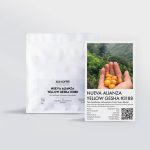How to improve access to finance for small-scale coffee farmers?
– TASTE THE ORIGIN –
In the current coffee industry, the global supply of coffee comes mainly from smallholder farmers (70-80%). Although accounting for a large proportion, 75% of them are living in poverty, lacking in many aspects. Many farmers who lack access to finance struggle, even at a standstill, with the development of their coffee farms and marketing of their products. Without investment, the finished products produced will not be guaranteed, not competitive enough, and the selling price will not be enough to bring profits to improve quality or maintain life. If this situation persists, coffee farmers trapped in a cycle of poverty will quit and switch to other crops. This directly affects the decrease in supply, price fluctuations and the sustainability of the coffee industry. So how do small-scale coffee farmers access financial resources (such as loans, credit)? Let’s find out with 43 Factory Coffee Roaster!
Reasons why small-scale coffee farmers have difficulty accessing financial support
There are many reasons why small-scale coffee farmers have difficulty accessing financial resources.
This is a systemic and revolving problem in most low-income countries, says Larissa Céron, a specialist at the Neumann Kaffee Gruppe (NKG) Sustainable Business Unit in Hamburg. The cause is due to the consequences of the economic downturn such as rising inflation, difficult access to credit,…. When this happens, financial institutions will give priority to providing credit, rights and privileges. loans for traders and sellers of short-term goods to increase liquidity and cash flow. Because transactions with coffee farmers are often long-term (annual contracts), the speed of cash flow is slow, making it less attractive to financial institutions.

In addition, coffee is a seasonal crop, depending on weather conditions and living environment. If there is a natural disaster such as a drought, prolonged purchase, etc., there may be crop failure, poor quality, and farmers will not have enough profit to pay for loans. This makes contracts with coffee farms often rated as high risk, so very few parties for investment choose.
Besides, the high interest rate is also the main reason preventing farmers from making loan transactions. Small-scale producers often have only one main source of income from coffee. However, because of limited resources, it is difficult to control the quality of the output and there is little long-term supply. Fluctuating prices also make it difficult for farmers to estimate income. They are afraid that if the production and business process has difficulties, they will not be able to pay. In addition, farmers lack relationships and have many limitations in financial knowledge, credit accounts, budget balance making it more difficult for them to successfully apply for credit or loans.

How to improve access to finance for small-scale coffee farmers?
The first thing to do to improve access to finance for small-scale coffee farmers is to improve the quality of their coffee and the profitability of their farms. According to José Manuel Calero Moraga – Director of FSU at Becamo, to do this organizations need to go on-site to provide technical support, practice farming, optimize resources including finance and improve capacity climate change resilience for farmers. For example, NKG Bloom has traveled to Honduras, Mexico, Kenya and Uganda to understand the situation and provide appropriate resources (cash, fertilizer, …) to each household. In the Uganda region alone, NKG Bloom has supported more than 25,000 farmers across 17 counties. This has increased the average productivity of these farms by 187%, the net income also increased by 189%. This growth not only helps farmers reduce risks associated with farm management and improves financial resilience, but it also gives them more confidence in borrowing for business.

Besides technical support and financial support, Rachel Nakasiita – Farmer Service Unit (FSU) Manager of NKG Bloom Uganda said that helping farmers improve financial literacy is also a way to improve access to this resource. When understanding the knowledge and thinking, financial skills, farmers will know how to choose the right credit service, build and manage the budget better. Thereby contributing to improving business efficiency, improving living standards and investing in coffee farms.
Manuel also added that personalizing loan agreements also improves access to finance for farmers. He said that if each farmer’s transaction information was updated in the system, it could provide better access to finance than them. It allows farmers to create a record of yield and loan performance, and then use this as a track record to demonstrate creditworthiness and behavior. This will make it easier for financial institutions or lenders to evaluate and assist farmers.

As can be seen, there are many ways to improve the financial access of small-scale coffee farmers, but doing so requires a lot of time and resources. But if action can be fostered throughout the supply chain, from large organizations and even at the government level, more and more farmers will be supported, empowered, scaled their farms, and scaled up their farms. transition from subsistence agriculture to high value sustainable agriculture. If you find this information useful, please share it with the community and don’t forget to follow 43 Factory Coffee Roaster to stay up to date with new news about the coffee industry!
Source: perfectdailygrind
Related articles:
– What does wild coffee farming mean for the coffee industry?
– World Coffee Research organization announced a new Robusta variety list
– Discover the acidity of coffee – How to identify coffee flavor through acidity






